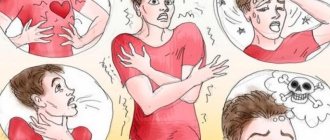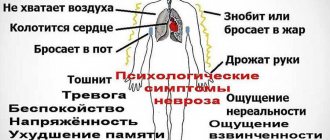Category: Human Psyche
Obsessive-compulsive neurosis is a type of neurosis characterized by recurring obsessive thoughts or actions that arise against the will and interfere with a person’s daily activities.
According to different versions, from 1% to 5% of people experience this type of disorder throughout their lives. Obsessive-compulsive disorder is not a gender-biased disease: it affects both women and men equally.
What is obsessive-compulsive disorder?
Obsessive-compulsive neurosis is a pathology in which a person is burdened with thoughts and ideas of an obsessive, restless, frightening nature, which in turn can prompt him to perform actions of a certain nature many times or periodically.
To understand what obsessive-compulsive neurosis is, you need to give examples:
- A person constantly forgets whether he turned off the kettle or iron.
- The person believes that public appliances are dirty, so one should bring one's own items.
- A person believes that all people are looking at him and judging him.
An elementary example of obsessive-compulsive neurosis is fear for the future. We can say that with neurosis, a person is afraid of precisely the future of the circumstances that he has now.
Where do worries and fears about the future come from? Why do people turn to psychics and fortune tellers with a desire to know their future? For what reasons does the future scare a person? There is actually no clear answer to such questions, since people are afraid of their future for various reasons.
- Fear of the future arises in a person's head. We can say that the picture of the future is clouded only by human imagination. His life is so stormy and full of negative images that the future is filled with various unpleasant events. This may be the influence of movies, many of which film events of the future, showing disasters and tragic developments of the situation. And a person, impressionable and suspicious, takes everything personally, thinking that the same thing will happen to him.
- Self-doubt makes you fear the future in advance. A person simply wants to predict what will happen to him in order to prepare, or rather, to escape from everything unpleasant. A person’s insecurity is caused by the fact that he is not sure that he can cope with any problems in his life. A person is always ready to experience joy. But the problems scare some people. And those people who are afraid of difficulties and problems are afraid of the future, which may still be fraught with many troubles.
- The habit of fearing the future. Sometimes a person is raised by his parents in such a way that the future seems scary to him. Parents might say: “We don’t know what will happen in the future. There could be war, there could be devastation.” All this frightens the child, who simply does not want the future to come. And a person unconsciously reproduces this habit in adulthood.
- The future is the unknown. The unknown is scary if a person is not ready for it. After all, the unknown always conceals something new that a person has not encountered before.
- The future is a lack of control. If you are afraid of darkness or fog just because you cannot control the situation and are afraid of facing something bad for yourself, then you also have fears about the future. Simply put, those people who like to control everything and everywhere are afraid of the future. But the future may not be subject to man, since it always contains circumstances that are beyond his control. And then it “hits him on the head” more than once, which is why he realizes that he is powerless. Since it is impossible to control, it means that you need to be afraid of it.
Where do worries and fears about the future come from? The question is multifaceted, and when answering it you need to communicate directly with the person in order to understand the reasons for his fear. But the main reasons have been listed here.
There are three forms of obsessive-compulsive neurosis:
- One-time – which lasts for weeks or months without stopping, while remaining at the same level of intensity or fading over the years.
- Remitting – signs of the disease either subside or worsen again.
- Progressive - fears are constantly aggravated, intensified, excitement increases, and new experiences are added.
After 40 years, the symptoms gradually smooth out, becoming permanent and familiar to the person.
Etiology
There is evidence of hereditary predisposition, when character traits and behavior patterns are inherent from birth. Provoking reasons are:
- Psychological: prolonged stress, sudden mental trauma (death of loved ones, natural disasters, attacks).
- Biological: it is believed that with obsessions, the exchange of serotonin and adrenaline is disrupted.
More often, OCD develops in psychasthenics who personally control everything, in people with a high degree of intelligence, who are accustomed to comprehensively thinking about problems and worry excessively.
Causes of obsessive-compulsive neurosis
Although obsessive-compulsive neurosis occurs less frequently than hysterical neurosis or neurasthenia, it has its own reasons for development:
- Physiological:
- Lack of serotonin.
- Heredity, when children suffer from the same diseases as their parents.
- Organic changes in the brain.
- Psychological:
- Psychotraumatic situations.
- Long-term stress that a person cannot emotionally cope with.
- A mental mindset of a personality that is more focused on one’s memories, thoughts, and ideas.
- Bipolar disorder.
- Addiction to alcohol or drugs.
Studies have also been conducted that have shown that obsessive-compulsive neurosis does not depend on a person’s material wealth, but it often occurs in people with a good higher education.
Video on the topic
Obsessive-compulsive neurosis: symptoms, treatment, what to do
On the Practical Psychology video channel, specialist Igor Bogush will talk about how to learn to live without fears, what neurosis is, what are the causes, and how to get rid of neurosis using simple methods. You can get a free online consultation with a psychologist here: https://www.b17.ru/?prt=115014.
How to get rid of obsessive thoughts: distract yourself, remove negative states
Course of psychotherapy for anxiety disorders: Zhavnerov Pavel Borisovich.
Psychologist for anxiety and emotional disorders. Certified clinical psychologist in the field of psychological correction and psychotherapy. Candidate of Sciences, as well as an official expert of the radio and newspaper “Komsomolskaya Pravda”.
Author of the book “Psychotherapy of Fear and Panic Attacks”, author of a system for getting rid of panic attacks and anxiety disorder which contains 26 video lessons, author of a step-by-step method of getting rid of anxiety disorder. It works within the framework of cognitive behavioral psychotherapy, which is recognized by the World Health Organization as the most effective in the treatment of anxiety-phobic disorders.
Provides consultations via Skype video all over the world. Received more than 100 reviews on the results of the psychotherapy course via Skype. More than 50 are video reviews.
Works with anxiety and emotional problems:
- panic attacks,
- vegetative-vascular dystonia,
- neurosis,
- anxiety disorder
- phobias,
- social phobia,
- hypochondria,
- obsessive thoughts,
- low self-esteem,
- increased emotionality, short temper, irritability, touchiness, tearfulness.
Today, the cost of a psychotherapy course is 50 thousand rubles (800 euros or $850) - this is a comprehensive, continuous work that includes weekly consultations and support via Skype chat throughout the course, as well as homework.
Before taking the course, there is a free consultation via Skype video call. You can apply for a free consultation on the website https://pzhav.ru/.
Psychologist's advice: get rid of obsessive thoughts!
Recommendations from an experienced psychologist, trainer, Gestalt therapist, family constellator, specialist in the field of couples counseling and marital therapy, family consultant, member of the Guild of Psychotherapy and Training of St. Petersburg Galina Noskova.
Fear of going crazy, losing control, harming yourself and loved ones
Pavel Fedorenko will tell you how to cure this problem once and for all!
Download books for free:
- “Happy life without panic attacks and fears” – https://goo.gl/l1qyok
- “Enjoying life without vegetative-vascular dystonia and anxiety” – https://goo.gl/aCZWKC
- “Happy life without obsessive thoughts and fears” – https://goo.gl/8sGFxG
How to treat obsessive-compulsive disorder: Pavel Fedorenko
Derealization, depersonalization: how to get rid of the symptoms of obsessive neurosis
Pavel Fedorenko's video channel contains effective ways and methods of managing your reality and defeating obsessive-compulsive neurosis.
Symptoms of obsessive-compulsive neurosis
Obsessive disorders are diagnosed in a person if for more than two weeks he was subject to obsessions and compulsions, which forced him to change his lifestyle, provoked a prolonged state of stress, worsened the quality of life and affected his performance.
The main symptom of obsessive-compulsive neurosis is thoughts and actions of an obsessive and stereotypical nature. They seem ridiculous to others. For the person himself, they have a certain meaning. Moreover, he cannot get rid of them, and they also cause him an anxious or fearful state.
The following signs of neurosis are distinguished:
- Fears and doubts - a person begins to doubt the actions he has taken, begins to redo everything, and double-checks.
- Intrusive thoughts – memories, ideas, melodies, etc.
- Phobia – a person with obsessive-compulsive neurosis begins to be very afraid of something specific. There are many phobias here:
- Cancerophobia is the fear of getting cancer.
- Mysophobia is the fear of getting dirty, which is why a person constantly washes and washes something.
- Gypsophobia and acrophobia are the fear of rising to heights and being on them.
- Agoraphobia is the fear of large crowds of people and open spaces.
- Erythrophobia and social phobia are people’s fear of being in public, of blushing in front of everyone.
- Xenophobia is the fear of the new and unknown.
- Claustrophobia is the fear of closed spaces.
- Fears-desires - arise when a person is already in a frightening situation. For example, when in water, he is afraid of drowning; when at a height, he is afraid to take a step forward.
- Obsessive counting is when a person begins to count everything.
- Obsessive movements - when thoughts force you to perform actions many times and constantly:
- Dermatillomania – picking off any irregularities from the skin.
- Onychophagia - nail biting.
- Trichotillomania – hair pulling.
- Inadequate perfectionism is when a person begins to achieve ideals and perfection in everything in order to minimize the circumstances that cause him to panic.
A person is driven by his fears that arise in his head. At the same time, he cannot abstract himself from them. They control him.
Who to turn to for obsessive neurosis?
You only need to contact a psychiatrist or a psychiatrist-psychotherapist. In this case, you should pay very close attention to the experience of this specialist directly in the field of psychiatry. An ordinary psychotherapist or psychologist, or any other specialist in such situations will not be able to provide really effective help with obsessive neurosis. Given the complexity of this type of neurotic disorder and the impossibility of controlling one’s own condition through the mind, primary care should be organized only by a psychiatrist. Primary care should only be medicinal. Why? We will explain this a little below. I would like to especially note that treatment of obsessive neurosis by any other specialist leads to only one thing. This is a deterioration of the condition and a significant difficulty in further therapy. At the same time, treatment of obsessive neurosis can become a lifelong process.
Diagnostics
To organize an effective therapeutic process for obsessive neurosis, a complete diagnosis is very important. Most cases of fiasco are associated precisely with the correct diagnosis of this mental condition. Similar symptoms can accompany many disorders of the nervous system, and the choice of the correct therapeutic plan depends on the accuracy of the diagnosis. We conduct individual diagnostics of the state of the nervous system from the point of view of the integrity of the entire organism, and not of an individual organ. Therefore, for each patient we organize a free consultation of five specialists. Based on a carefully collected history and individual objective data, we first establish a working diagnosis, which can be corrected during observations during active therapy. Accordingly, during the period of active therapy, when the main symptoms are relieved, the most important diagnostic work also takes place. Based on this, we formulate the main treatment for obsessive neurosis or other disorder.
Obsessive-compulsive disorder in children
Children can also experience obsessive-compulsive disorder. In young children, they manifest themselves in the form of twitching their shoulders, drawing on paper without conscious participation, the desire to clean everything, stamping their feet or clapping their hands. In teenage children, this can manifest itself in the fear of speaking in front of an audience, dying, or getting sick.
Unfortunately, parents rarely take this condition seriously, which certainly will not go away on its own. Therefore, you need to seek qualified help.
Treatment of obsessive-compulsive disorder neurosis
Depending on the severity of obsessive-compulsive neurosis, specific treatment is carried out. In a mild form, this condition can be eliminated with the help of hypnosis or training in new actions in a state of obsessive actions. If a person has a moderate or severe form of neurosis, then antidepressants and other medications are prescribed. Inpatient treatment is possible.
You can resort to breathing exercises that should calm the person. Traditional medicine is also practiced here, offering the preparation of decoctions and teas of a soothing nature.
Only a doctor can treat obsessive-compulsive neurosis. It is almost impossible to get rid of it on your own.
Psychocorrection of disorder
Obsessiveness and obsession are a purely psychological disorder that can be corrected by appropriate methods. Psychotherapy for obsessive-compulsive neurosis is based on various theoretical schools and, with true OCD, always gives positive results. Obsession syndrome and its symptoms are successfully treated in the following areas:
- transactional analysis;
- psychoanalysis;
- hypno-suggestive therapy and hypnosis;
- cognitive behavioral therapy.
Transactional analysis in the treatment of OCD
Transactional analysis is an excellent technique for suppressing obsessive movement neurosis in children.
Work in this direction is short-term and helps in the early stages of the development of OCD, but in chronic and severe cases it is unlikely to be effective. Transactional analysis helps to “play out” the patient’s entire life scenario again, give strength to the Self and cope with the disorder. Among young clients, the results of group therapy are noticeable, which helps to overcome obsessive states in children and defuse the “stuck” affect that caused the disease.
Psychoanalysis in the treatment of OCD
Most neuroses come to us from childhood - this is the main postulate of Freudianism. Therefore, the neurosis of obsessive thoughts grows from childhood. The client’s task in this direction is to understand the causes of this condition, the fixations that caused the disorder and, with the help of a psychotherapist, understand how to deal with obsessive thoughts and actions.
During psychoanalytic sessions, the client gradually redirects the energy of neurosis (after all, it is a defense mechanism) into more favorable ways of protecting himself from the problem he is experiencing and, through catharsis, achieves liberation from OCD.
Below we list the pitfalls of this approach:
- forced treatment and sexually aggressive interpretation of the symptom is not the most pleasant thing for the patient (psychoanalysis is built on the ideas of sexuality and aggression);
- this is a long-term method that requires the establishment of an extremely trusting therapist-patient relationship, and initially the client always resists interference in his intimate experiences;
- psychoanalysis is not a painless process - the patient has to face his weaknesses;
- at certain moments the syndrome may worsen - especially when the internal conflict is about to be resolved.
Therefore, inexperienced psychoanalysts are not always able to successfully correct obsessive thoughts and OCD in general. Moreover, this is an “adult” method; obsessive movements in a child cannot be corrected through psychoanalysis in principle.
Cognitive behavioral therapy in the treatment of OCD
This type of therapy is the most popular in the treatment of obsessive-compulsive disorder. In essence, the patient is left face to face with his phobias, forcing him to fight what he is running from. Starting from 12-14 years of age, this therapy helps to overcome both obsessive movements in children and ritual behavior in adults.
To begin with, the patient is placed in conditions in which the obsession loses its motivating power, then the therapist “brings to light” the fears and fixations that underlie obsessive-compulsive neurosis and teaches the client to detect and restructure erroneous and absurd thoughts.
As a result, the patient “challenges” his obsessive thoughts and obsessions to a duel and literally says goodbye to them in a friendly manner; Now the healthy patient knows how to distract himself from obsessive thoughts.
Having brought to the level of consciousness the reasons for certain thoughts and actions, the patient learns to calmly and with humor (by the way, this is mandatory) to catch interfering thoughts and sort them out from the general flow.
This type of psychotherapy is the best for children, helping to overcome obsessive movements in a child. Moreover, the therapy sessions are quite friendly and include interesting techniques that children will enjoy. In addition, children work in a group, which helps not only to successfully cope with the disease, but also to master new and adaptive styles of behavior with peers.
Hypnosis in the treatment of OCD
Hypnosis as a method of correcting OCD is used in conjunction with one of the above methods. It is not effective on its own because it helps control the symptoms of the disease, but not its causes.
But for children, hypno-suggestive therapy may be the only method of treatment - children trust the therapist without fear and easily enter special states of consciousness in which the hypnologist forms new attitudes regarding obsessions.











